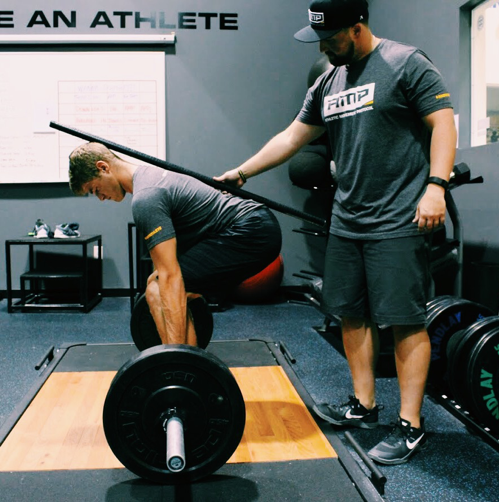
Deadlifting Part 1 – Why You Shouldn’t Deadlift Until You’ve Mastered the Hip Hinge
Out of all exercises in existence, the Deadlift might be the purest display of full body strength because it stresses just about the entire musculoskeletal system from head to toe. There’s something about pulling heavy weight off the ground that gets us feeling all macho-like. The Conventional Deadlift begins by flexing at the hips and gripping the bar with an overhand grip (setup), and moving the hips from flexion into extension while keeping a neutral spine. There are several variations that work the body differently, like the Romanian Deadlift, Hex Bar Deadlift, Sumo Deadlift and Single Leg Deadlift. Deadlifting has the potential to cause some fairly serious harm to the body when performed incorrectly, especially when done repetitively with heavy weight. Deadlifting requires adequate mobility, stability, core strength, and appropriate progression. Your low back, ankles, knees, hips or bicep tendons may start screaming at you if you’re not conscious of technique.
Here are a few reasons why the Deadlift reigns supreme.
- Deadlifting strengthens the glutes, spinal erectors and core muscles. When these muscle groups are strong and functioning properly, they help prevent back pain.
- Deadlifting elicits a great endorphin release, causing that euphoric “feel good” sensation.
- Deadlifting shreds your Latissimus Dorsi muscles.
- Deadlifting can help athlete’s improve in several areas of their sport.
- Learning how to breathe and execute the abdominal brace while heavy deadlifting crushes the core (in a good way).
- Maxing out causes testosterone and growth hormone release, leading to hypertrophy.
- Runners can improve their velocity and sprinting power by fitting the Deadlift in their strength training programs.
- Deadlifting helps the aging population sustain strength. (If you don’t use it, you lose it.)
- Deadlifts have a great effect on cardiopulmonary health.
- There are several variations of the Deadlift that stress the body in different planes.
Now before we go load up a Barbell and try to break our PR let’s talk about this lift from a mobility standpoint. Perhaps the biggest reason people struggle with deadlifting is they have not mastered the Hip Hinge. If you’re serious about developing adequate lower body strength, (some upper body as well) it’s imperative you engrain this movement pattern into your brain, because you will also need it for squats, kettle bell swings, etc. Until you’ve mastered this movement pattern, Deadlifts are not the lift you want to mess around with. It never hurts to put the ego aside and seek help from an experienced fitness professional to keep an eye on form before it’s too late. No two bodies are the same, what works for Joe the offensive lineman at Penn State may not work for Joe from accounting. A good coach should know when and how to make appropriate modifications. Here are a few boxes I like to check off with my clients before deadlifting, regardless of their age, experience or ability level.
- Does he/she have a solid Hip Hinge?
- Are there any faulty alignments present? (asymmetries)
- Is there a loss of spinal stability during their Hip Hinge?
- Can they get into the starting position and create tension in the starting position?
So what is a hip hinge? A hip hinge is the ability to get the hips to move while not allowing the lumbar spine (low back) to flex along with it. This phenomenon is often referred to as ‘Lumbopelvic disassociation’. When the hips cannot move the way we need them to during the Deadlift, we compensate by recruiting our low back to take over the daunting task of pulling heavy weight. The result is you compromise the integrity of your spine by asking it to do a job it wasn’t designed to do. The spine’s job is to protect the spinal cord, give structural support and stability to maintain healthy posture, and facilitate flexible motion. It’s important to bear in mind that barbell Deadlifting is not the only way to learn how to deadlift. I often teach this movement using anything from medicine balls to kettlebells.

Hinging at the hip is the most important movement we must sustain for injury prevention, particularly in the low back. It’s no secret that the majority of society is immobile. According to the CDC, only one in four US adults and one in five US high school students meet the recommended physical activity guidelines. We spend so much of our time in our cars, hunched over at our desks at work or school, and slouched forward on our phones that our mobility escapes us somewhere down the road. This is why somebody can suffer a low-back injury by simply picking up a laundry basket.
So, how can we learn to master this movement?
Stay tuned for Part 2!
Author: Michael LeFebvre – B.S / C.S.C.S
Michael has been a strength coach at Olympia Fitness and Performance for three years. Michael graduated from Rhode Island College where he studied Community Health & Wellness with a concentration in Wellness & Movement studies. After graduating, Mike went on to get his CSCS (certified strength and conditioning specialist) through the NSCA. In his three years as a strength coach, Mike has helped clients from all walks of life improve their fitness levels. He has a strong passion for helping young athletes not just improve their athletic performance, but also helping them build confidence.
Sources
- Cook, Gray, et al. Movement: Functional Movement Systems. Screening-Assessment-Corrective Strategies. Santa Cruz, California, 2010.
- 55 Reasons Why The Deadlift is The Best Exercise of All Time. The PTDC, 2011-Dean-Somerset. https://www.theptdc.com/deadlift-exercise
- Expert Shows Exercises for Training the Hip Hinge. The PTDC, 2011-Dean-Somerset. https://www.theptdc.com/expert-shows-exercises-for-training-the-hip-hinge

